TOYOTA AVALON HYBRID 2020 (in English) Workshop Manual
Manufacturer: TOYOTA, Model Year: 2020, Model line: AVALON HYBRID, Model: TOYOTA AVALON HYBRID 2020Pages: 560, PDF Size: 11.03 MB
Page 51 of 560
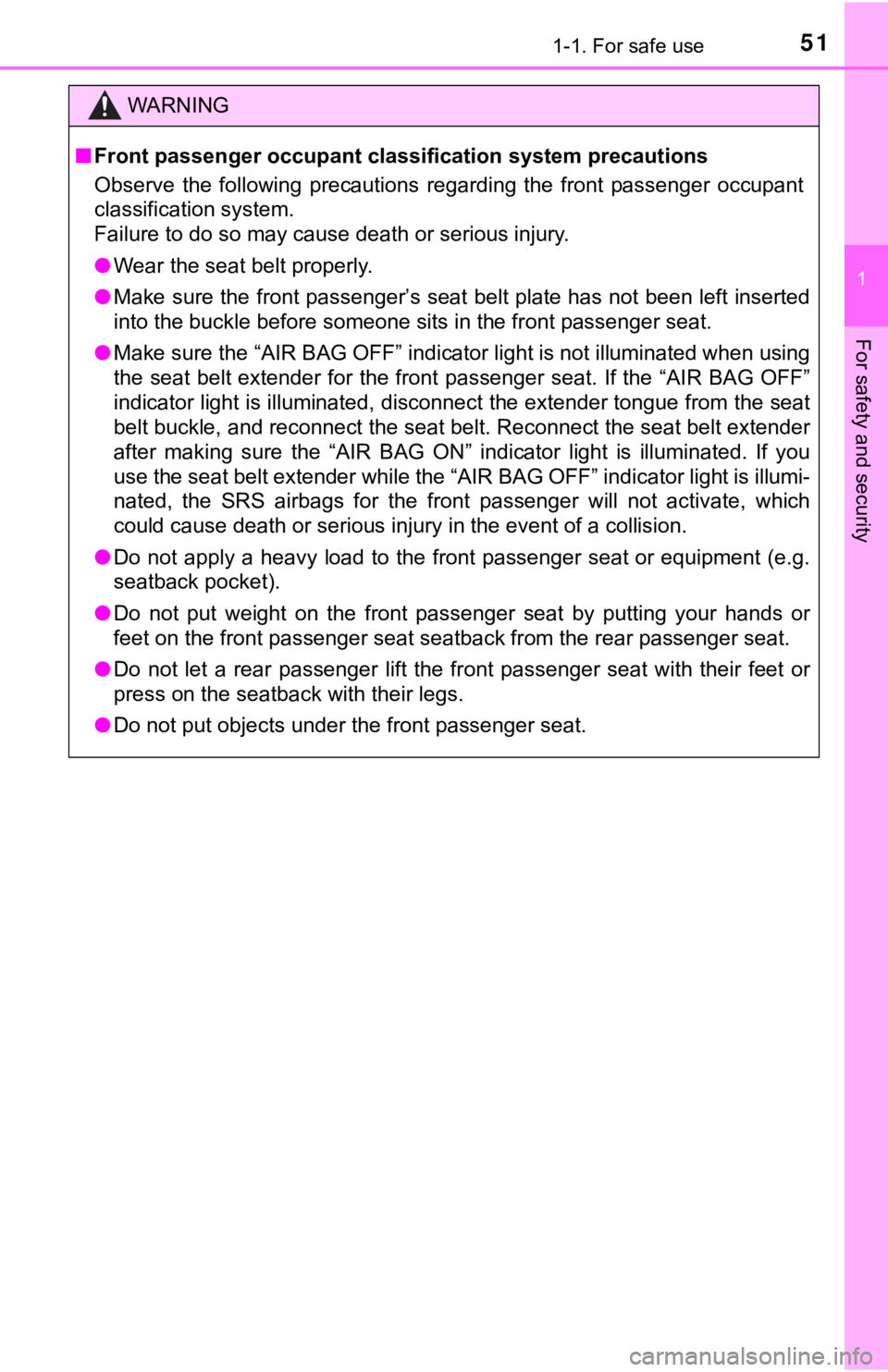
511-1. For safe use
1
For safety and security
WARNING
■Front passenger occupant classification system precautions
Observe the following precautions regarding the front passenger occupant
classification system.
Failure to do so may cause death or serious injury.
● Wear the seat belt properly.
● Make sure the front passenger’s seat belt plate has not been le ft inserted
into the buckle before someone sits in the front passenger seat .
● Make sure the “AIR BAG OFF” indicator light is not illuminated when using
the seat belt extender for the front passenger seat. If the “AI R BAG OFF”
indicator light is illuminated, disconnect the extender tongue from the seat
belt buckle, and reconnect the seat belt. Reconnect the seat be lt extender
after making sure the “AIR BAG ON” indicator light is illuminated. If you
use the seat belt extender while the “AIR BAG OFF” indicator li ght is illumi-
nated, the SRS airbags for the front passenger will not activate, which
could cause death or serious injury in the event of a collision .
● Do not apply a heavy load to the front passenger seat or equipm ent (e.g.
seatback pocket).
● Do not put weight on the front passenger seat by putting your hands or
feet on the front passenger seat seatback from the rear passeng er seat.
● Do not let a rear passenger lift the front passenger seat with their feet or
press on the seatback with their legs.
● Do not put objects under the front passenger seat.
Page 52 of 560

521-1. For safe use
WARNING
■Front passenger occupant classification system precautions
● Do not recline the front passenger seatback so far that it touc hes a rear
seat. This may cause the “AIR BAG OFF” indicator light to be il luminated,
which indicates that the SRS airbags for the front passenger wi ll not acti-
vate in the event of a severe accident. If the seatback touches the rear
seat, return the seatback to a position where it does not touch the rear
seat. Keep the front passenger seatback as upright as possible when the
vehicle is moving. Reclining the seatback excessively may lesse n the
effectiveness of the seat belt system.
● If an adult sits in the front passenger seat, the “AIR BAG ON” indicator
light is illuminated. If the “AIR BAG OFF” indicator is illuminated, ask the
passenger to sit up straight, well back in the seat, feet on the floor, and
with the seat belt worn correctly. If the “AIR BAG OFF” indicat or still
remains illuminated, either ask the passenger to move to the re ar seat, or
if that is not possible, move the front passenger seat fully re arward.
● When it is unavoidable to install a forward-facing child restra int system on
the front passenger seat, install the child restraint system on the front pas-
senger seat in the proper order. ( P. 58)
● Do not modify or remove the front seats.
● Do not kick the front passenger seat or subject it to severe im pact. Other-
wise, the SRS warning light may come on to indicate a malfuncti on of the
front passenger occupant classification system. In this case, contact your
Toyota dealer immediately.
● Child restraint systems installed on the rear seat should not c ontact the
front seatbacks.
● Do not use a seat accessory, such as a cushion and seat cover, that cov-
ers the seat cushion surface.
● Do not modify or replace the upholstery of the front seat.
● Do not place anything between the console box and front passeng er seat.
Otherwise, the system may not detect the front passenger proper ly, lead-
ing to improper operation of the airbags.
● Adjust the front passenger seat so that the head restraint does not touch
the ceiling. If the head restraint is left in contact with the ceiling, the system
may not detect the front passenger properly, leading to imprope r operation
of the airbags.
Page 53 of 560
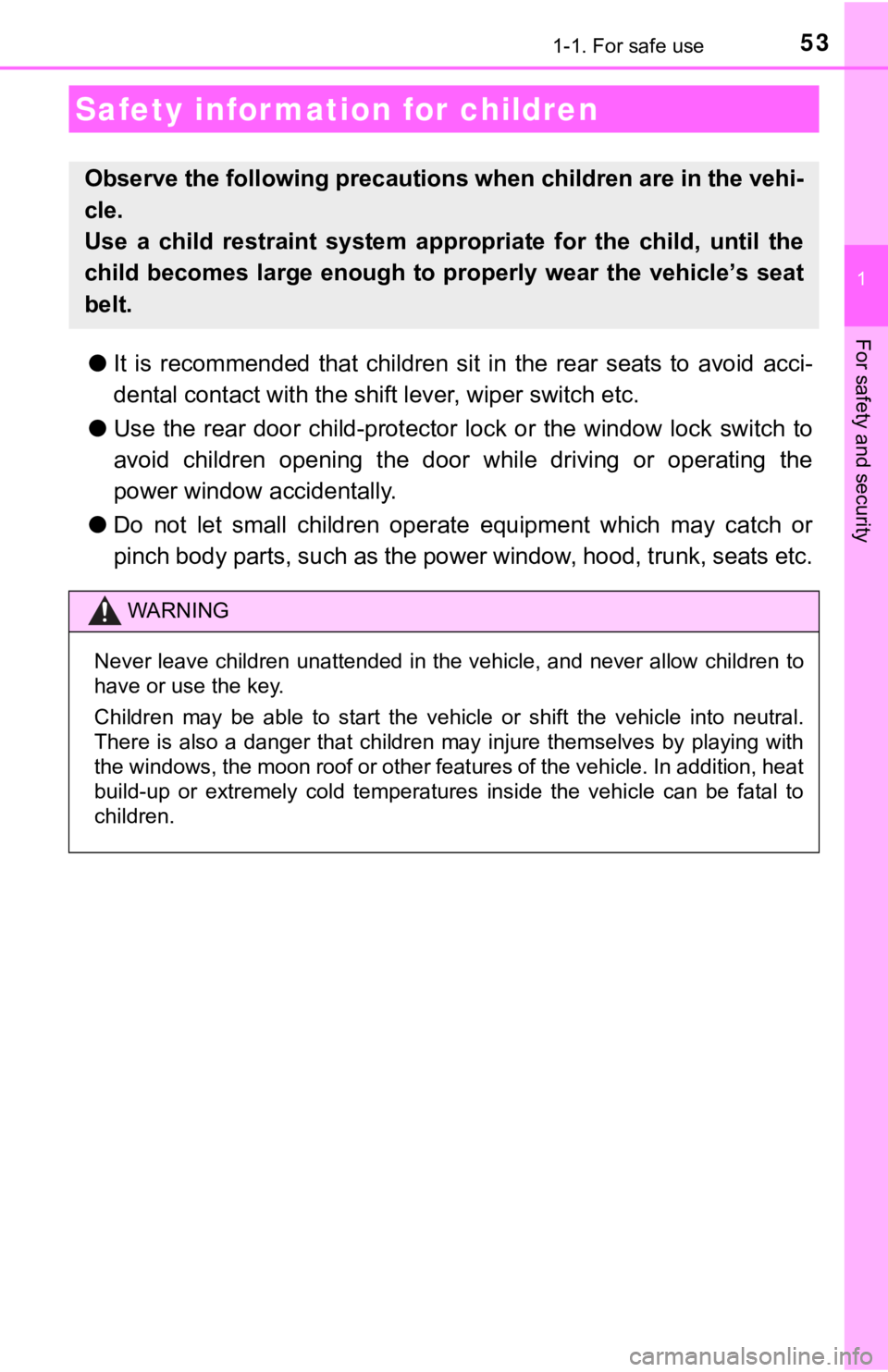
531-1. For safe use
1
For safety and security
●It is recommended that children sit in the rear seats to avoid acci-
dental contact wit h the shift lever, wiper switch etc.
● Use the rear door child-protector lock or the window lock switc h to
avoid children opening the door while driving or operating the
power window accidentally.
● Do not let small children operate equipment which may catch or
pinch body parts, such as the power window, hood, trunk, seats etc.
Safety information for children
Observe the following precautions when children are in the vehi -
cle.
Use a child restraint system app ropriate for the child, until the
child becomes large enough to properly wear the vehicle’s seat
belt.
WARNING
Never leave children unattended in the vehicle, and never allow children to
have or use the key.
Children may be able to start the vehicle or shift the vehicle into neutral.
There is also a danger that children may injure themselves by p laying with
the windows, the moon roof or other features of the vehicle. In addition, heat
build-up or extremely cold temperatures inside the vehicle can be fatal to
children.
Page 54 of 560
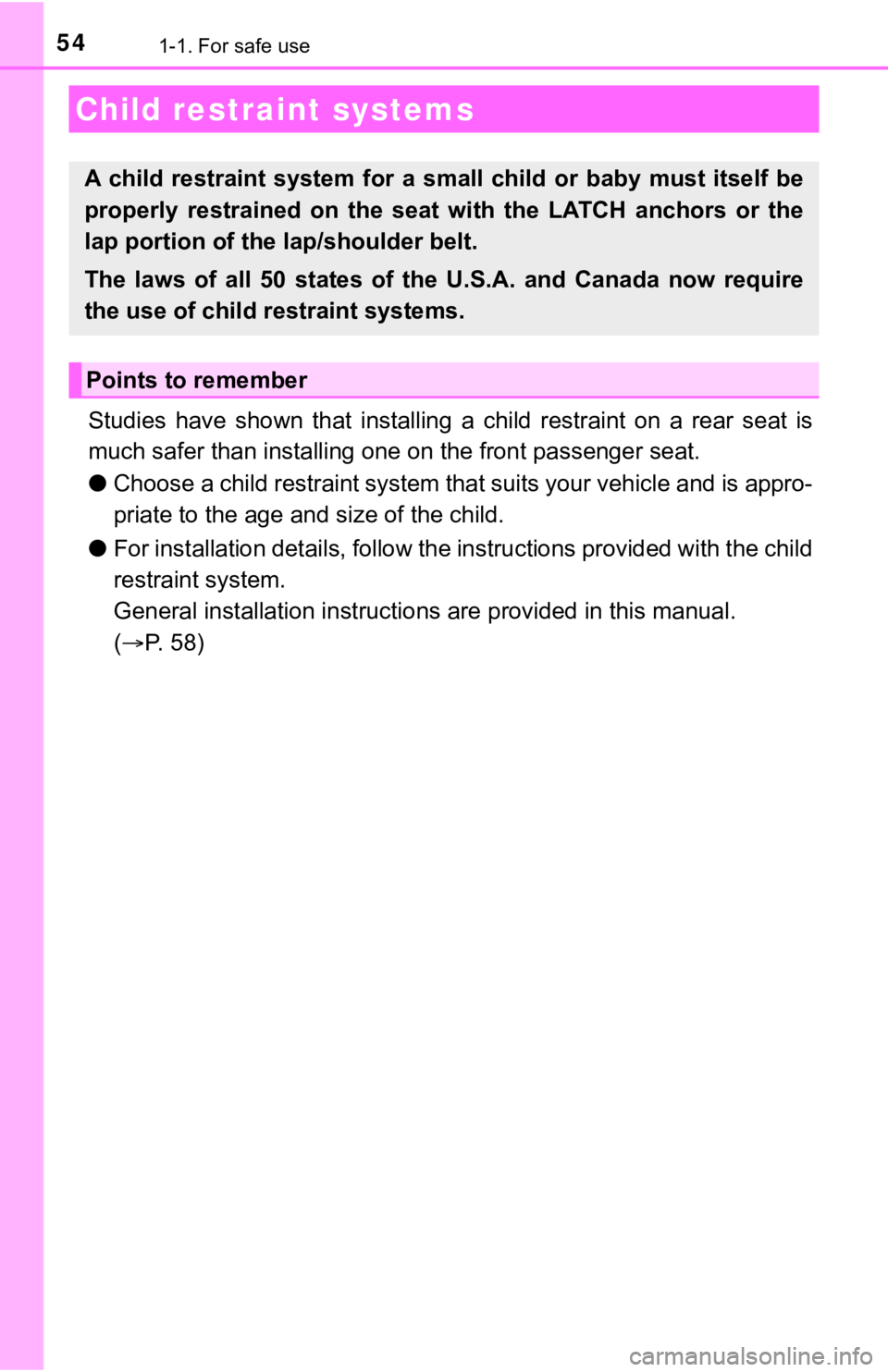
541-1. For safe use
Studies have shown that installing a child restraint on a rear seat is
much safer than installing one on the front passenger seat.
● Choose a child restraint system that suits your vehicle and is appro-
priate to the age and size of the child.
● For installation details, follow the instructions provided with the child
restraint system.
General installation instructio ns are provided in this manual.
( P. 58)
Child restraint systems
A child restraint system for a small child or baby must itself be
properly restrained on the seat with the LATCH anchors or the
lap portion of the lap/shoulder belt.
The laws of all 50 states of th e U.S.A. and Canada now require
the use of child restraint systems.
Points to remember
Page 55 of 560
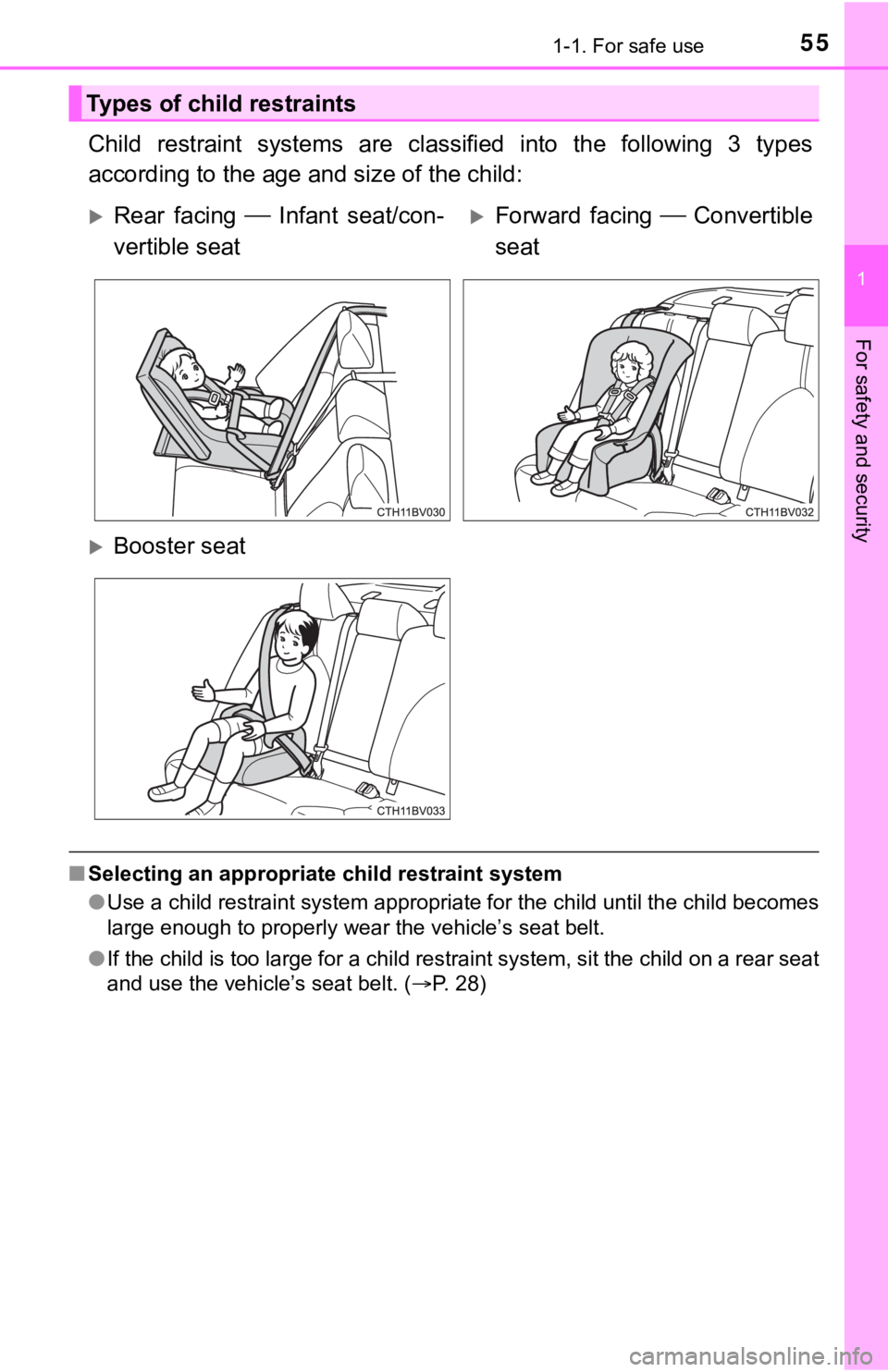
551-1. For safe use
1
For safety and security
Child restraint systems are classified into the following 3 types
according to the age a nd size of the child:
■Selecting an appropriate child restraint system
●Use a child restraint system appropriate for the child until th e child becomes
large enough to properly wear the vehicle’s seat belt.
● If the child is too large for a child restraint system, sit the child on a rear seat
and use the vehicle’s seat belt. ( P. 28)
Types of child restraints
Rear facing Infant seat/con-
vertible seatForward facing Convertible
seat
Booster seat
Page 56 of 560

561-1. For safe use
WARNING
■Child restraint precautions
● For effective protection in automobile accidents and sudden sto ps, a child
must be properly restrained, using a seat belt or child restrai nt system
depending on the age and size of the child. Holding a child in your arms is
not a substitute for a child restraint system. In an accident, the child can be
crushed against the windshield, or between you and the vehicle’ s interior.
● Toyota strongly urges the use of a proper child restraint syste m that con-
forms to the size of the child, installed on the rear seat. According to acci-
dent statistics, the child is safer when properly restrained in the rear seat
than in the front seat.
● Never install a rear-facing child restraint system on the front passenger
seat even if the “AIR BAG OFF” i ndicator light is illuminated.
In the event of an accident, the force of the rapid inflation o f the front pas-
senger airbag can cause death or serious injury to the child if the rear-fac-
ing child restraint system is installed on the front passenger seat.
● A forward-facing child restraint system may be installed on the front pas-
senger seat only when it is unavoidable. A child restraint system that
requires a top tether strap should not be used in the front passenger seat
since there is no top tether strap anchor for the front passenger seat.
Adjust the seatback as upright as possible and always move the seat as
far back as possible even if the “AIR BAG OFF” indicator light is illumi-
nated, because the front passenger airbag could inflate with considerable
speed and force. Otherwise, the child may be killed or seriously injured.
● Do not use the seat belt extender when installing a child restr aint system
on the front or rear passenger seat. If installing a child rest raint system
with the seat belt extender connected to the seat belt, the seat belt will not
securely hold the child restraint system, which could cause dea th or seri-
ous injury to the child or other passengers in the event of a s udden stop,
sudden swerve or accident.
● Do not allow the child to lean his/her head or any part of his/ her body
against the door or the area of the seat, front and rear pillar s or roof side
rails from which the SRS side airbags or SRS curtain shield air bags deploy
even if the child is seated in the child restraint system. It is dangerous if
the SRS side airbags and curtain shield airbags inflate, and th e impact
could cause death or serious injury to the child.
● Make sure you have complied with all installation instructions provided by
the child restraint manufacturer and that the system is properl y secured. If
it is not secured properly, it may cause death or serious injury to the child
in the event of a sudden stop, sudden swerve or an accident.
Page 57 of 560
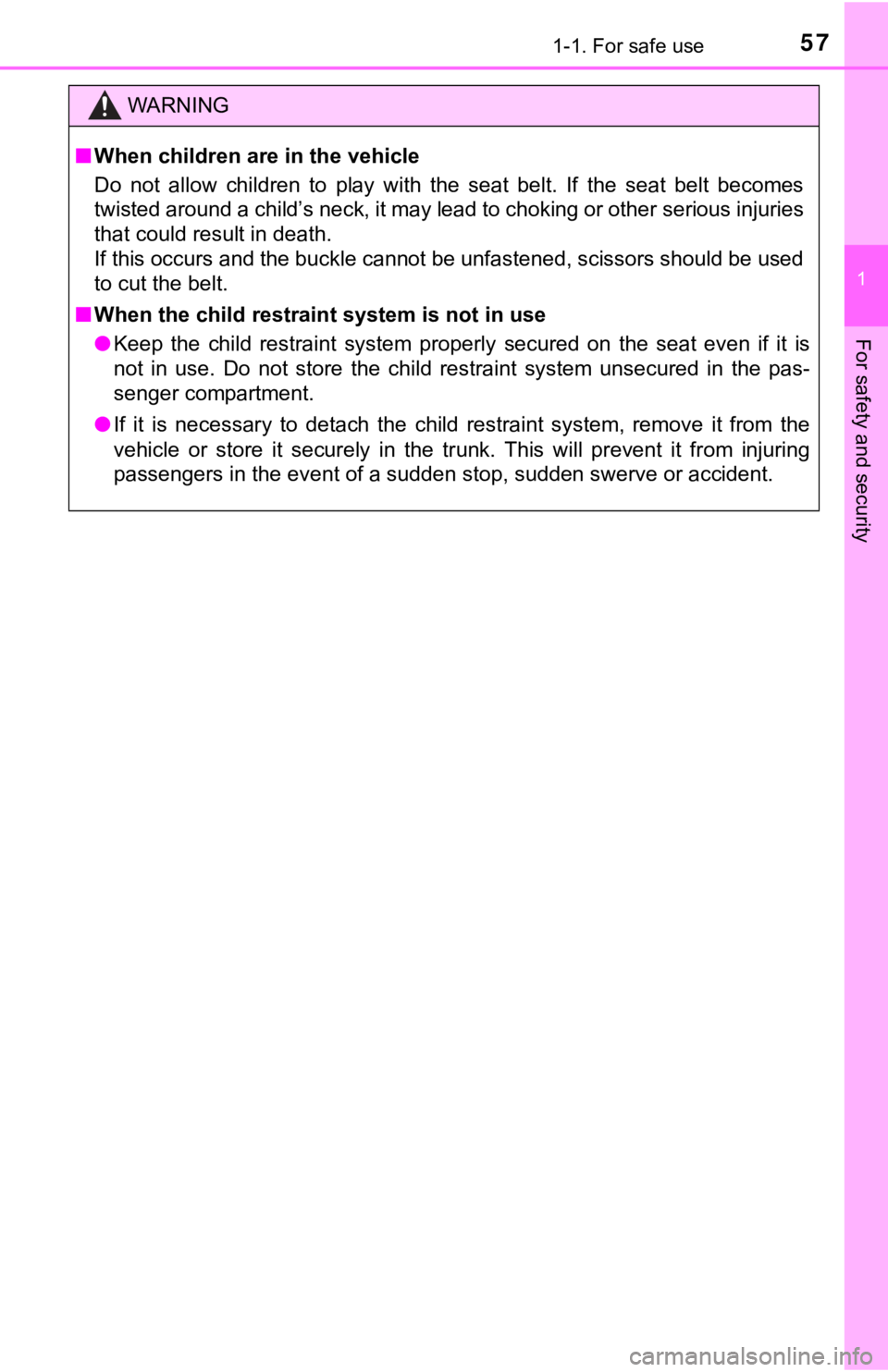
571-1. For safe use
1
For safety and security
WARNING
■When children are in the vehicle
Do not allow children to play with the seat belt. If the seat belt becomes
twisted around a child’s neck, it may lead to choking or other serious injuries
that could result in death.
If this occurs and the buckle cannot be unfastened, scissors sh ould be used
to cut the belt.
■ When the child restraint system is not in use
● Keep the child restraint system properly secured on the seat ev en if it is
not in use. Do not store the child restraint system unsecured in the pas-
senger compartment.
● If it is necessary to detach the child restraint system, remove it from the
vehicle or store it securely in the trunk. This will prevent it from injuring
passengers in the event of a sudden stop, sudden swerve or acci dent.
Page 58 of 560
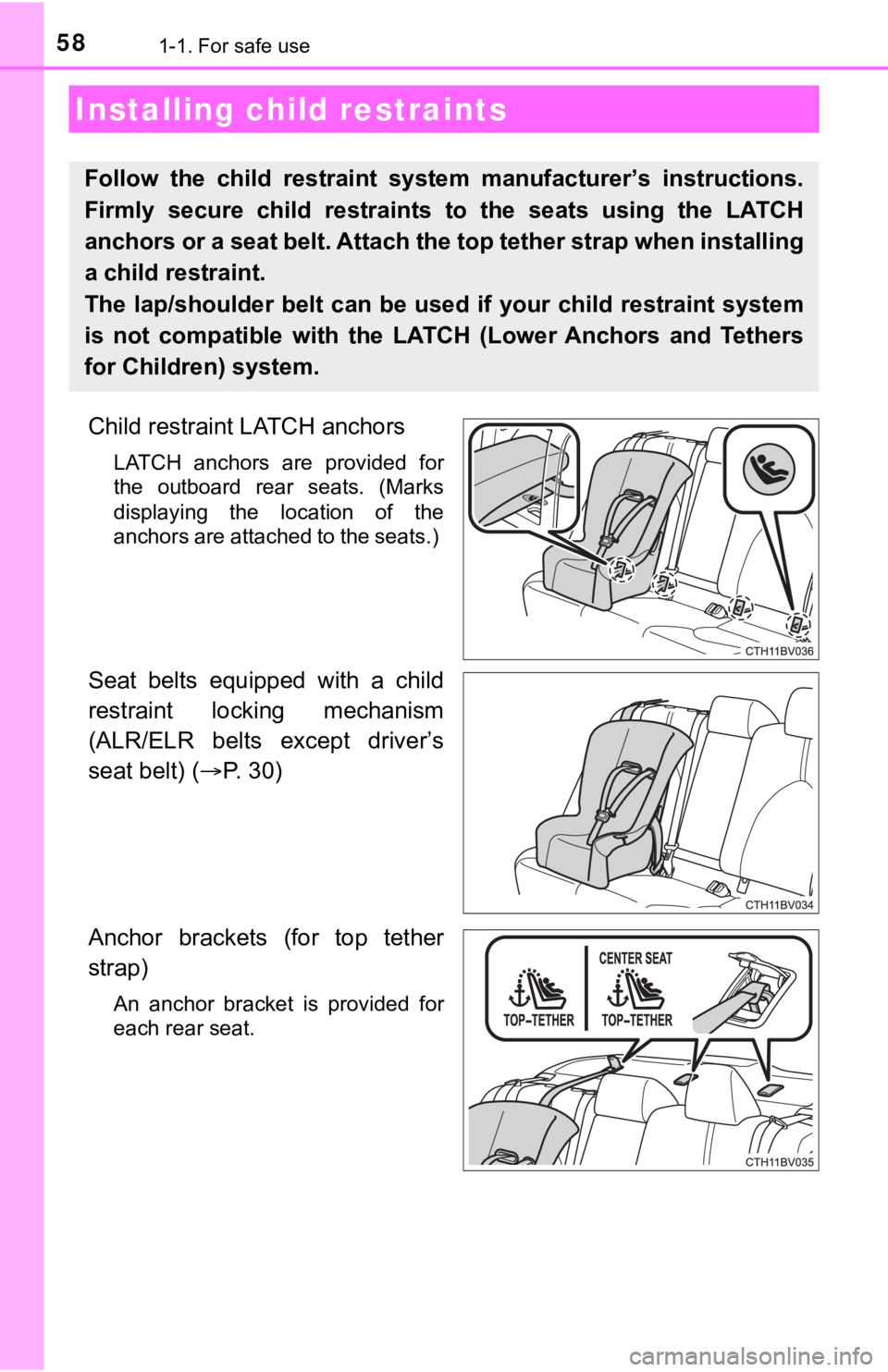
581-1. For safe use
Child restraint LATCH anchors
LATCH anchors are provided for
the outboard rear seats. (Marks
displaying the location of the
anchors are attached to the seats.)
Seat belts equipped with a child
restraint locking mechanism
(ALR/ELR belts except driver’s
seat belt) (P. 30)
Anchor brackets (for top tether
strap)
An anchor bracket is provided for
each rear seat.
Installing child restraints
Follow the child restraint system manufacturer’s instructions.
Firmly secure child restraints to the seats using the LATCH
anchors or a seat belt. Attach t he top tether strap when installing
a child restraint.
The lap/shoulder belt can be used if your child restraint syste m
is not compatible with the LATCH (Lower Anchors and Tethers
for Children) system.
Page 59 of 560
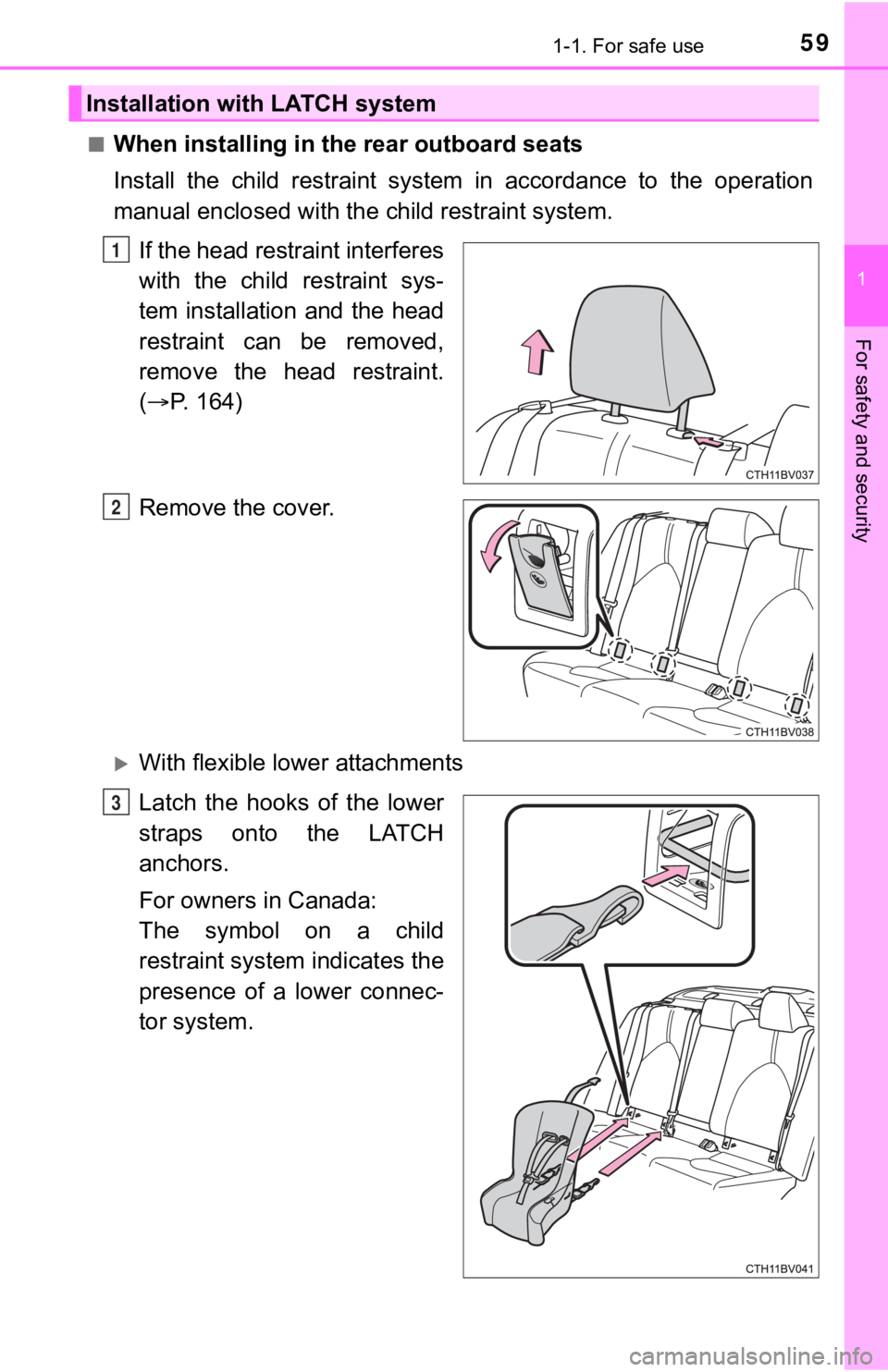
591-1. For safe use
1
For safety and security
■When installing in the rear outboard seats
Install the child restraint system in accordance to the operation
manual enclosed with the child restraint system.
If the head restraint interferes
with the child restraint sys-
tem installation and the head
restraint can be removed,
remove the head restraint.
( P. 164)
Remove the cover.
With flexible lower attachments
Latch the hooks of the lower
straps onto the LATCH
anchors.
For owners in Canada:
The symbol on a child
restraint system indicates the
presence of a lower connec-
tor system.
Installation with LATCH system
1
2
3
Page 60 of 560
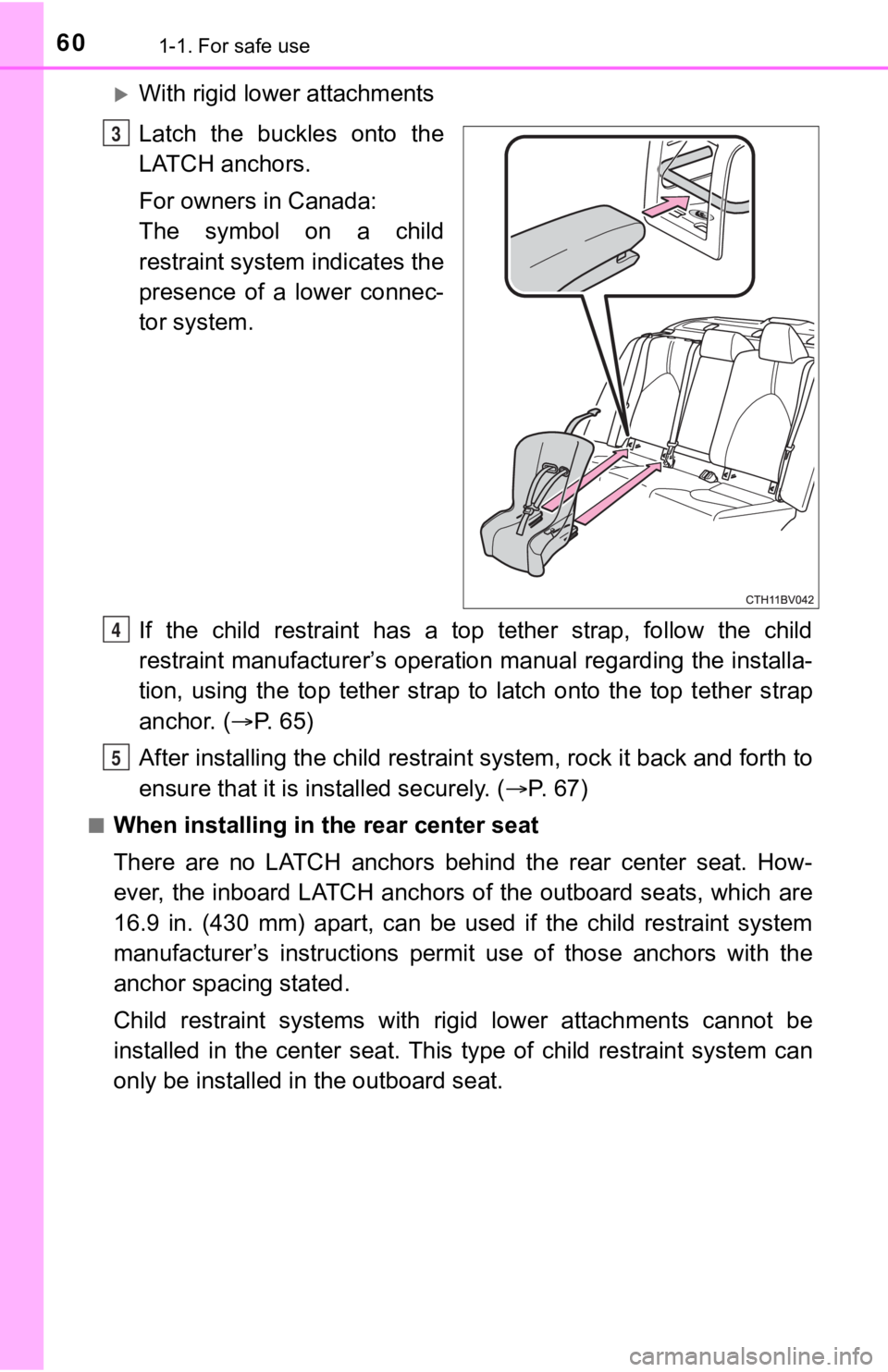
601-1. For safe use
With rigid lower attachments
Latch the buckles onto the
LATCH anchors.
For owners in Canada:
The symbol on a child
restraint system indicates the
presence of a lower connec-
tor system.
If the child restraint has a top tether strap, follow the child
restraint manufacturer’s operation manual regarding the installa-
tion, using the top tether strap to latch onto the top tether s trap
anchor. ( P. 6 5 )
After installing the child restrai nt system, rock it back and forth to
ensure that it is in stalled securely. ( P. 67)
■When installing in the rear center seat
There are no LATCH anchors behind the rear center seat. How-
ever, the inboard LATCH anchors of the outboard seats, which are
16.9 in. (430 mm) apart, can be used if the child restraint sys tem
manufacturer’s instructions permit use of those anchors with th e
anchor spacing stated.
Child restraint systems with rig id lower attachments cannot be
installed in the center seat. This type of child restraint syst em can
only be installed in the outboard seat.
3
4
5